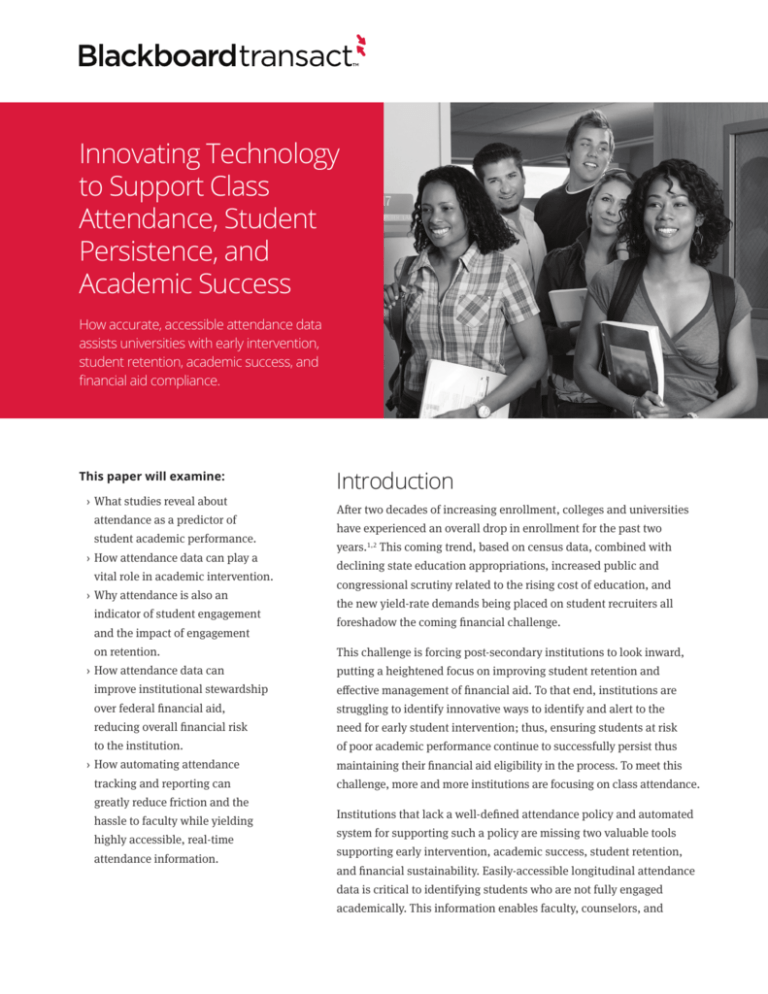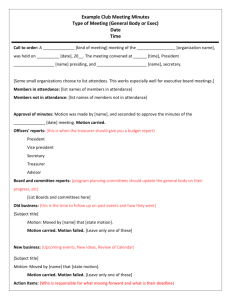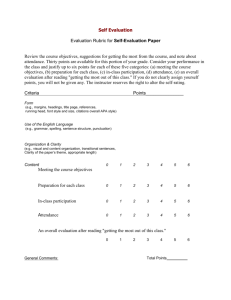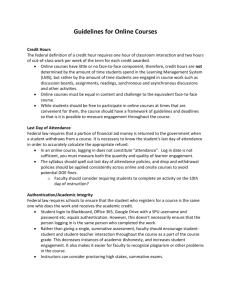
Innovating Technology
to Support Class
Attendance, Student
Persistence, and
Academic Success
How accurate, accessible attendance data
assists universities with early intervention,
student retention, academic success, and
financial aid compliance.
This paper will examine:
›› What studies reveal about
attendance as a predictor of
student academic performance.
›› How attendance data can play a
vital role in academic intervention.
›› Why attendance is also an
indicator of student engagement
and the impact of engagement
on retention.
›› How attendance data can
Introduction
After two decades of increasing enrollment, colleges and universities
have experienced an overall drop in enrollment for the past two
years.1,2 This coming trend, based on census data, combined with
declining state education appropriations, increased public and
congressional scrutiny related to the rising cost of education, and
the new yield-rate demands being placed on student recruiters all
foreshadow the coming financial challenge.
This challenge is forcing post-secondary institutions to look inward,
putting a heightened focus on improving student retention and
improve institutional stewardship
effective management of financial aid. To that end, institutions are
over federal financial aid,
struggling to identify innovative ways to identify and alert to the
reducing overall financial risk
need for early student intervention; thus, ensuring students at risk
to the institution.
of poor academic performance continue to successfully persist thus
›› How automating attendance
tracking and reporting can
greatly reduce friction and the
hassle to faculty while yielding
highly accessible, real-time
attendance information.
maintaining their financial aid eligibility in the process. To meet this
challenge, more and more institutions are focusing on class attendance.
Institutions that lack a well-defined attendance policy and automated
system for supporting such a policy are missing two valuable tools
supporting early intervention, academic success, student retention,
and financial sustainability. Easily-accessible longitudinal attendance
data is critical to identifying students who are not fully engaged
academically. This information enables faculty, counselors, and
administrators to engage
before students find
themselves failing,
or worse, unofficially
withdrawing by walking
off campus. Easilyaccessible attendance
information also helps
colleges and universities
demonstrate competency
during Accreditation
Reviews and A-133
Audits that determine an
institution’s compliance
with Title IV requirements
related to the awarding
and disbursing of federal
student financial aid.
Easily-accessible
longitudinal attendance
data is critical to identifying
students who are not fully
engaged academically.
The Impact of Attendance on
Student Academic Performance
It seems logical that students who do not attend classes
will not perform as well in their academic careers. How
much learning can take place in the absence of having
enough discipline to attend lectures? Many studies have
been conducted to determine the impact of attendance
on academic performance in higher education. Most
conclude that higher attendance levels are correlated to
superior performance.
›› In 2004, Colby investigated the relationship
between attendance and academic performance in
a first-year course module. Attendance was strongly
correlated to performance and Colby was able to
derive several rules. Colby’s Seventy Percent Rule
states a student that attends less than 70% of the
time has a two in three chance of failing the course.
The Two-Week Rule finds a level of non-attendance
during the first two weeks of class, for any reason,
spells academic trouble.
2
›› In 2006, Burd and Hodgson attempted to
›› How many credits a student has achieved is a
corroborate the findings of Colby on a different
reliable predictor of persistence. As they attain more
group of students—this time computer science
credits, students become less likely to walk away.
majors. The study corroborated the general findings
A University of Illinois analysis revealed that of
of Colby, noting also that the most poorly attended
students who dropped out, “about two-thirds of
classes were first thing in the morning.
the students departed with 60 credit hours or less,
3
›› In 2009, Bevitt, Baldwin, and Calvert studied
with the highest proportion having departed with
attendance and performance among first year
between 16 and 30 cumulative credit hours (i.e.,
biosciences students at Newcastle University. The
during the freshman year).”7 This pattern helps
institution avoided some of the hassles associated
explain why freshman are most likely to leave,
with attendance by only monitoring ‘high stakes’
followed by sophomores. It also underscores the
classes (seminars and practicums). The authors
importance of getting students to attend class and
noted that “attendance and performance monitoring
perform well academically, so they can earn credits.
combined with early, pro-active
follow-up of non-attendance”
delivered positive results in
identifying at risk students, and
that monitoring attendance in the
high stakes classes was as effective
as monitoring all sessions.4
If attendance is correlated with academic
performance, does it also follow that
academic achievement contributes
to student persistence and retention?
Recent studies support this premise:
›› Over a ten-year follow-up period,
the Educational Longitudinal Study
of 2002 found that 32% of high
school students enrolled in some postsecondary
education without achieving any credential.
Among minority students, attrition was higher;
40% of African American students and 39% of
Hispanic students enrolled, but did not achieve a
postsecondary credential.5
›› Departure rates are highest among freshmen college
students, with about 30% dropping out on average.
However, attrition rates vary widely, and highly
In an effort to get freshman students off on the right
foot and reinforce good academic patterns for returning
sophomores, many colleges and universities are now
instituting policies requiring faculty to record attendance
in 100 and 200 level courses. By the third and fourth year
of college, students have generally formed their habits
about studying and attending class, therefore, taking
attendance has less impact on performance.
selective and private institutions often measure
higher rates of freshman persistence than public,
less selective institutions.6
Blackboard.com/transact
3
The Role of Attendance Data in Early Intervention and Retention
Student retention is critical for the financial vitality of a college or university. More than 40% of full-time college students
fail to graduate within six years. According to Mike Reilly, executive director of the American Association of Collegiate
Registrars and Admissions Officers, schools are under pressure to boost retention rates, and that’s leading to more
campus-wide policies about attendance.8 Well-known institutions such as Xavier University and University of Arkansas
are working to increase retention, in part through better tracking of attendance.
Students who feel a sense of engagement and connection to their campus community have an 80% higher chance of
persisting.9 As with academic performance, student attendance in class is also related to student retention. Because
attendance data can be one measure of a student’s level of academic engagement, innovative colleges and universities
have begun to use it for predictive purposes. These schools monitor attendance and other indicators of student
engagement, with interdiction processes in place for students who are most at risk of leaving without a degree.
Increasingly, attendance monitoring is being noted as a best practice for student retention efforts:
›› A recent ACT policy report on retention recommends that colleges and universities, “Implement an early alert,
assessment, and monitoring system based on HSGPA, ACT Assessment scores, course placement tests, first
semester college GPA, socioeconomic information, attendance records, and non-academic information derived
from formal college surveys and college student inventories to identify and build comprehensive profiles of
students at risk of dropping out.”10
›› A University of Texas study listed attendance as a high impact practice for community college student success,
noting that for many schools, developing a campus-wide attendance policy may be the “lowest hanging fruit” that
is a “simple, inexpensive step” to improve academic outcomes and graduation rates.11
›› In defining ten elements of successful retention programs, the Noel-Levitz National Center for enrollment
management recommends that colleges and universities:12
1. “Collect, compile, and analyze pertinent retention data and research”
2. “Implement early identification/alert and intervention strategies”
4
With tracking systems, institutions can use classroom
attendance/absence patterns as an early predictor
of retention. If the attendance system is tied into the
centralized system for student credentials, additional
“attendance” information can be gathered about ancillary
campus services and social events to provide a larger
picture of overall engagement. This enables colleges and
universities to identify behavior patterns that indicate risk
factors for retention and get the right personnel involved
early. Two examples include:
›› Several institutions use a system based around
student ID cards that tracks how often students
attend campus-sponsored parties, studentleadership programs, and how often they check
in at the career center. Some universities even
incentivize students who qualify for Pell Grants with
a rewards system based on participating in activities
they track.13
›› City University of New York (CUNY) developed a
structured degree pathway for students eligible
for need-based aid. The pathway features several
components, including block scheduling of classes,
advising, and mandatory, full-time attendance.
Attendance Tracking and
Compliance with Federal
Financial Aid Rules
According to National Center for Education Statistics,
approximately eighty-five percent (85%) of full-time
students pay for college with the help of financial aid in
the form of grants and scholarships.15 Federal financial aid
is responsible for a large number of students being able
to afford post-secondary education, so it’s important for
institutions to be good stewards of this valuable resource
and not compromise the institution’s ability to participate
The program doubled the graduation of students
in Title IV programs.
compared to those not in the program.14
As of March 2015, the Department of Education disclosed
As more colleges and universities decide to implement
broader, campus-wide attendance tracking, it will be
necessary to implement innovative technology and
processes that reduce or eliminate friction to alleviate the
burden on faculty of taking attendance, thus increasing
faculty adoption. Both change management and financial
cost/benefit need to be taken into consideration with the
implementation of any technology. It has already been
established that there is a significant loss in revenue to
an institution associated with not taking attendance;
however more important, there is also a significant loss in
earning potential for the student that drops out, as well
as experiencing other life-long impacts. The next section
will address such costs and impacts as they relate to
federal requirements.
that it is closely monitoring the financial health of 556
postsecondary educational institutions, or about 10% of
all institutions receiving federal student aid and grants.16
Of those, most have a status of HCM-1 (heightened cash
monitoring), but 69 are subject to more stringent financial
restrictions known as HCM-2 status, including 21 under
active federal investigation.17 According to Inside Higher
Ed, HCM-2 status “means that department employees
manually approve every dollar that flows to an institution.
Nearly all of those unidentified colleges were on that status
because a federal audit of the institution resulted in ‘severe
findings’.”
In this era of increased financial scrutiny by federal and
state government, colleges and universities are tightening
Blackboard.com/transact
5
their reporting standards and improving information
systems to ensure strict compliance with financial
aid requirements. Attendance plays a role in many
of these requirements:
›› Federal financial aid regulations require that an
institution must be able to document attendance
in each class for which a student has received
Title IV aid.
In this era of increased
financial scrutiny by federal
and state government,
colleges and universities are
tightening their reporting
standards and improving
information systems to
ensure strict compliance with
financial aid requirements.
Attendance plays a role in
many of these requirements.
›› If a student has a change in enrollment status, and
drops or adds a class, an institution is required to
determine if this has an impact on the student’s
financial aid package. In the case of the dropping of
a class that results in a change in enrollment status—
and it impacts eligibility—the institution must adjust
the student’s aid package and return funds to the
Title IV program(s) or report the student’s status to
NSLDS if the funds have been previously disbursed.
›› In the case of both an Official and Unofficial
Withdrawal, the institution must perform a Return
to Title IV calculation (R2T4). Foundational to this
calculation is the student’s Documented Last Date
of Attendance. In the case of an Official Withdrawal,
the specific date the student stopped attending all
classes is critical to ensure the institution does not
return too little or too much to the US Department
of Education (the “Department”). In the case of an
unofficial withdrawal, if the institution is unable to
provide requisite documentation that the student
attended at least one day of class for which the
student was paid, the student is deemed to never
have established Title IV eligibility and thus all aid
must be returned to the Department.
›› Finally, there is a date certain that Title IV funds
must be returned to the Department. In general, this
is no later than 14 days after the withdrawal.
With these requirements, it’s easy to see why creating
better policies for tracking attendance is beneficial for
both students and institutions. If a financial aid award
has been disbursed and is owed back to the Department,
the institution must return the money promptly and try to
6
collect these monies from the student. Given the student’s
questions become, “How can we make this easier on our
lower earnings potential without a degree and the fact the
faculty?” and “How do we ensure our faculty maximizes
student was eligible for financial aid, the likelihood of the
their time teaching and not taking attendance?”
institution collecting from the student is remote.
The answer can be found in automation.
From a compliance oversight perspective, one example of
Automating Attendance
Tracking and Reporting
a potentially-costly Title IV Program Review performed by
the Department occurred when auditors sampled student
loan accounts at a state university and found 56% “didn’t
Clearly, tracking attendance can help institutions identify
students in danger of underperforming academically
as well as help engage and retain students. Keeping
careful attendance records also supports the institution’s
compliance with Federal Financial Aid requirements
for audits and in the event of a Federal Program Review.
However, taking attendance manually has proven
historically challenging, burdensome, time-consuming,
error prone, and frustrating for faculty members
and administrators.
At many universities, the discretion for taking attendance
is left up to individual departments or even individual
professors. The administration may encourage attendance
taking, but not mandate it. This flexibility in policy results
in confusion in several ways:
›› Students will attend classes where attendance is
have enrollment status updates reported to the federal
government in a timely manner. . . That meant the students
got a little extra time before having to repay their debts,
but the campus risked federal disallowance for noncompliance, meaning future federally backed loans could
have been in jeopardy.”18
In 2014, the Department cited that R2T4 calculation errors
taken (particularly if attendance is a component of
grading) while skipping classes in which attendance
is not taken.
›› Faculty members often view attendance as extra,
unnecessary effort because the lack of a definitive
policy and its related benefits; thus, making it seem
unimportant to the institution.
›› If the university is subjected to a federal or state
and late return of program funds were number two (2)
audit, administrators will be hard-pressed to
and four (4) in the top ten audit findings respectively. As
produce accurate records because it will be unclear
mentioned earlier, the institution’s ability to determine last
which professors actually take attendance and if
date of attendance is foundational to the calculation and
timely return of program funds.
Once an institution decides to take advantage of the
benefits of more in-depth attendance monitoring, the next
they do so on a consistent basis.
›› If it is unknown which professors take attendance,
those records will be difficult to obtain to
demonstrate compliance.
Blackboard.com/transact
7
The most common complaint from faculty is that taking
For example, a Cloud-based attendance system that
attendance is time-consuming and a hassle. In a freshman
leverages existing campus technology can provide the
or sophomore lecture course, it is impractical to call
automation needed to centralize attendance records while
roll with hundreds of students. Some universities have
also making them easily accessible to faculty members for
attendance systems that enable a faculty member to check
grading and review purposes. If that system also includes
in students on a laptop, or print out a student roster to
an easy way for students to “check in” as they enter class,
pass around and then later input the information back
an attendance system can minimize class disruption
into the attendance system.
and save time for faculty by
Both are active processes that
reducing friction.
must be heavily managed by
the professor.
If a manual method is used
for taking attendance, the
professor must further ensure
that records are complete, valid,
and properly-maintained or
delivered to the registrar in the
likely event a question arises
about attendance in relation
The credential is
increasing in usage
across every aspect
of campus life.
Thus, it can provide
an institution critical
information in
support of retention...
One system approach involves
leveraging the student credential
(Campus ID card or mobile
phone as the ID) to facilitate
attendance tracking utilizing
purpose-built mobile readers.
On most campuses, student
credentials are already set up
to provide contactless or cardswipe functionality for financial
to withdrawals or grades. If
transactions or door access to enter
faculty members take attendance
buildings and dorms. Checking
on paper, there is additional
in for attendance is as simple as
complexity centralizing and retrieving manual attendance
students swiping or tapping their credentials against a
records for use in financial aid compliance or in the event
purpose-built reader mounted just inside the class room,
of an audit.
sitting on the instructor’s desk, or passed around studentto-student if class is being held outside or in an alternate
Automated Attendance Systems for
Postsecondary Institutions
location. This way, attendance is taken instantly, without
Many colleges and universities will choose an automated
The credential is increasing in usage across every aspect
attendance system to make monitoring attendance as easy
of campus life. Thus, it can provide an institution critical
as possible for faculty and students. Systems should be
information in support of retention though proactive
evaluated based on ease of use, as well as the availability
student programs, earlier intervention for students at-risk,
of this information to the enterprise. This will ensure
and more effective management of Title IV compliance.
student retention specialists can use this information
for predicting at-risk students and the institutions can
execute early intervention strategies as well as ensure
financial aid administrators have up-to-date information
to manage compliance.
8
hassle and with minimal friction to faculty and students.
Conclusion
Ensuring the success of students, both academically and
later professionally, is essential to building the reputation
and brand of any college or university. As institutions
seek more ways to engage with students and ensure
their academic success, many will discover the value of
monitoring attendance combined with data analytics.
Class attendance is highly correlated to improved
academic performance for all students, especially for
freshmen and sophomores.
Attendance is also one of several important measurements
of student engagement. Engaged students in all aspect of
campus life are much more likely to persist at college and
earn a degree than students who are less engaged. Given
eighty-five percent (85%) of full-time students receive
financial aid, attendance-linked persistence minimizes
the probability of students leaving without a degree; and
in turn, falling into default related to the repayment of
financial aid as a result of under-employability and/or a
lack of desire to pay for an education they perceive they
did not get.
In today’s environment, student recruitment is more
competitive and costly. Student retention is essential to
financial sustainability and takes pressure off recruiters, allowing them to focus on filling the next freshman class as
opposed to also refilling next year’s sophomore class.
The criteria for the most effective and efficient attendance systems will be the reduction of cycle time, friction, and
faculty frustration in taking attendance. A good system will provide easy access to data and support early intervention
and ultimately retention. Attendance Systems that integrate with the campus credentialing system make it very easy for
students to register their attendance by using their IDs. This attendance data is easily combined with other data streams
and incorporated into a bigger picture of campus engagement for administrators focusing on students at-risk, ensuring
retention, student success, and institutional financial health.
Blackboard.com/transact
9
End Notes
1 Institute of Education Sciences, “Fast Facts: Enrollment,” National Center
for Education Statistics. Retrieved from: http://nces.ed.gov/fastfacts/display.
asp?id=98
2 U.S. Census Bureau, “College Enrollment Declines for Second Year in a Row,
Census Bureau Reports,” September 24, 2014. Retrieved from: http://www.census.
gov/newsroom/press-releases/2014/cb14-177.html
3 E. Burd and B. Hodgson, “Attendance and Attainment: a five year study,”
Innovation in Teaching and Learning in Information and Computer Sciences, Vol.
5 No. 2, 2006. Retrieved from: http://journals.heacademy.ac.uk/doi/abs/10.11120/
ital.2006.05020004
4 Debbie Bevitt, Chris Baldwin and Jane Calvert, “Intervening Early: Attendance
and Performance Monitoring as a Trigger for First Year Support in the
Biosciences,” Bioscience Education, June 16, 2010. Retrieved from: http://
journals.heacademy.ac.uk/doi/abs/10.3108/beej.15.4
5 U.S. Department of Education, “Educational Longitudinal Study of 2002: A
First Look at 2002 High School Sophomores 10 Years Later,” National Center for
Education Statistics, January 2014.
6 U.S. News and World Report, “Freshman Retention Rates,” 2012.
7 Debra Bragg, Daniel Cullen, Stacy Bennett, and Collin Ruud, “All or Nothing?
Midpoint Credentials for Students Who Stop Short of the Baccalaureate Degree,”
University of Illinois at Urbana-Champaign, November 15, 2011, pgs. 9-10.
8 Douglas Belkin, “Cracking Down on Skipping Class,” Wall Street
Journal, January 14, 2015. Retrieved from: http://www.wsj.com/articles/
crackingdownonskippingclass1421196743.
9 Noel-Levitz Research – Mid-Year Retention Indicators Report. Retrieved
from: https://www.noellevitz.com/documents/shared/Papers_and_
Research/2011/2011MIDYEARINDICATORSREPORT.pdf
10 Veronica Lotkowski, Steven Robbins, and Richard Noeth, “The Role of
Academic and Non-Academic Factors in Improving College Retention,” ACT Policy
Report, 2004. Retrieved from: https://www.act.org/research/policymakers/pdf/
college_retention.pdf
11 Center for Community College Student Engagement, “A matter of degrees:
Practices to pathways (High-impact practices for community college student
success),” Austin, TX: The University of Texas at Austin, Program in Higher
Education Leadership, 2014. Retrieved from: http://www.ccsse.org/docs/Matter_
of_Degrees_3.pdf
12 Lydia Voigt, Ph. D. and Jim Hundrieser, “Student Success, Retention, and
Graduation: Definitions, Theories, Practices, Patterns, and Trends,” Noel-Levitz
National Center for Enrollment Management, November 2008. p. 16.
13 Goldie Blumenstyk, “Blowing Off Class? We Know,” New York Times, December
2, 2014. Retrieved from: http://www.nytimes.com/2014/12/03/opinion/blowing-offclass-we-know.html?_r=0
14 Center for Community College Student Engagement
15 National Center for Educational Statistics. “Fast Facts” Retrieved from: http://
nces.ed.gov/fastfacts/display.asp?id=3t
16 Aldemaro Romero Jr., “The feds are watching colleges and universities,”
The Edwardsville Intelligencer, April 20, 2015. Retrieved from: http://www.
theintelligencer.com/local_news/article_d3b921d0-e776-11e4-bb66-77515aa0e3f4.
html
17 Michael Stratford, “Cash Monitoring List Unveiled,” Inside Higher Ed, March
31, 2015. Retrieved from: https://www.insidehighered.com/news/2015/03/31/
education-department-names-most-colleges-facing-heightened-scrutiny-federal
18 Andy Koen, “Audit found weaknesses in CSU-Pueblo bookkeeping,” KOAA
Channel 5 news, May 13, 2005. Retrieved from: http://www.koaa.com/
story/29048025/audit-found-weaknesses-in-csu-pueblo-book-keeping
Page 5 photo credit: University of Oklahoma College of Education students. Taken
by Jawanza Bassue. Used with permission of the photographer.
Blackboard.com/transact
10
Copyright © 2015. Blackboard Inc. All rights reserved. Blackboard, the Blackboard logo, BbWorld, Blackboard Learn, Blackboard Transact, Blackboard Connect, Blackboard Mobile, Blackboard
Collaborate, Blackboard Analytics, Blackboard Engage, Edline, the Edline logo, the Blackboard Outcomes System, Behind the Blackboard, and Connect-ED are trademarks or registered
trademarks of Blackboard Inc. or its subsidiaries in the United States and/or other countries. Blackboard products and services may be covered by one or more of the following U.S. Patents:
8,265,968, 7,493,396; 7,558,853; 6,816,878; 8,150,925








